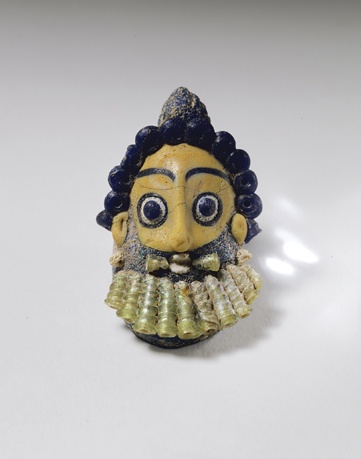
Glass
H: 6.3 cm
Provenance: no indication
Phoenician or Carthaginian
4th-3rd century B.C.
Rod-formed (sand-core glass): hot glass is wound to the desired shape over a pointed metal rod coated with clay or sand as a separating agent, a suspension loop is added, after which individual features are applied by means of tooled blobs and threads of different coloured glass.
Condition: slight fissures over facial layer.
The earliest type of head-pendants date to the 6th century B.C. and were produced in Phoenicia (Lebanon-Palestine). A more evolved type [1] was probably made in the latter's main colony Carthage as a great many of these pendants have been found there. Other find-spots, some of which were also production centres, correspond on the whole to Phoenician and Carthaginian settlements and trading outposts: Cyprus, Rhodes, Egypt and South Russia to the east; Sardinia, Sicily, Ibiza and Spain to the west.
These pendants are highly ornamental elements of necklaces; their function was certainly not religious, though possibly sometimes talismanic. Most have been found outside of stratigraphic or datable contexts, but there is sufficient evidence to ascribe the present type to the 4th-3rd century B.C.
1 Type C3 according to Seefried, M.: Les pendentifs en verre sur noyau des pays de la Méditerranée antique (Rome, 1982).